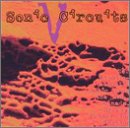| All Artists: Various Title: Sonic Circuits 5 Members Wishing: 1 Total Copies: 0 Label: Innova Original Release Date: 11/24/1998 Release Date: 11/24/1998 Genres: Jazz, Classical Styles: Chamber Music, Instruments, Electronic, Symphonies Number of Discs: 1 SwapaCD Credits: 1 UPC: 726708611422 |
Search - Various :: Sonic Circuits 5
 | Various Sonic Circuits 5 Genres: Jazz, Classical
|
Larger Image |
CD Details |
CD ReviewsAn eclectic mix of electroacoustic works Steve Benner | Lancaster, UK | 09/09/2002 (3 out of 5 stars) "Each year, the American Composers Forum (ACF) produces an audio CD of recent electronic and electroacoustic music by composers from around the world, principally for distribution to radio stations and other recorded music venues. Each of these discs provides a snapshot of the current state of experimental electronic music, as well as a ready-made programme of works for broadcast or performance.This fifth "Sonic Circuits" CD is the 1997 release from the ACF. One common theme running through most of the works on it is the use of vocal (or voice-like) material as a principal component. Most obviously, this is in the form of speech largely left raw and untreated, as with the spliced and looped radio broadcast samples which make up the entirety of Orchid Spangiafora's "Radios silent", or else the taped telephone conversations of Michael Schell's work, "Jerry Hunt: Song Drape 2", or the snippets of taped interviews juxtaposed with other processed sounds in Katharine Norman's "Hard Cash (and small dreams of change)". Lawrence Fitts uses a one-minute spoken text by Australian sound poet Chris Mann as the source of his short series of variations, each the result of increasing amounts of processing, whilst a commercial recording by the Hilliard Ensemble provided Colby Leider with the source material for his heavily processed "Veni Creator Spiritus". Robert Normandeau draws on vocal samples of the actors from Odile Magnan's radio adaptation of Antoine de Saint-Exupéry's "Le petit prince"(together with his incidental music for that production) for his engaging piece of 'cinema for the ears', "Le renard et la rose".Although not featuring real voices as such, both Eirik Lie's "112 Par Sko (112 pairs of shoes)" and Beatriz Ferreyra's "Soufle d'un petit Dieu distrait (The breath of a small, distraught god)" manage to give the impression of voices embedded within them. Eirik Lie's guitar work (commemorating the centenary of the terrible Verdal landslide of 1893 in which 112 Norwegians lost their lives) contains overtones of people's screams of terror, while the artificial electronic sound world of Beatriz Ferreyra's substantial composition carries various vocal connotations of a somewhat gentler (though still ominous) kind.Despite this thin thread of commonality running through the works on this disc, though, the overall programme presented here never comes across as the slightest bit unified and I suspect that different listeners will point to different tracks as providing the best listening. To my mind, the most important works here are the three longest ones: "Le renard et la rose" was a 1995 ICMC commission, and continues Robert Normandeau's cycle of works inspired by vocal onomatopoeia which began with "Spleen" in 1991. This newer work is very much a continuation of the earlier and uses heavily processed and augmented vocal (but wordless) utterances to build pulsing rhythmic and sonic structures which speak directly of human emotions in a way that recognisable words never could. It is a powerful and potent acousmatic work indeed.Similarly, the Argentinean-born composer Beatriz Ferreyra never fails to impress with her output. Her entirely synthetic (I'd guess) sound study here conjures all up manner of images, both light-hearted and vaguely threatening, suggestive, as is its title, of something partly comic, yet with the potential to be dangerously fey.Using recorded interviews carried out on the streets of London, together with ambient sound recordings from the gaming arcades and fun-fair on Brighton Pier, as well as computer-processed samples of spinning coins, Katharine Norman's contribution builds an entertaining and illuminating portrait of late twentieth century attitudes to life in south-east England. This work would make an interesting coda to her earlier London triptych.These three works aside, though, the disc strikes me as struggling ever to rise above mediocre - although this may simply be because the rest of the music is just not to my taste (although I have to confess a great liking for Eirik Lie's sombre electric guitar lament, which despite its brevity has some potent imagery woven through its dark and moving tapestry). And indeed, I would hazard that the variety of styles presented here works well for this disc's intended purposes; it would certainly be both unrealistic and misleading for the ACF to give the impression that all its members produce similar sounding music. As a source of a wide range of items for broadcasting use, therefore, this release should prove invaluable. Equally, this disc - together with the others in the series - should prove of worth to serious students of electroacoustic music of the end of the twentieth century and beyond; a fitting complement to the releases from the likes of CDCM, for instance. As an item for consumption at home, however, this disc may be less attractive. Anyone unfamiliar with the works here would be well advised to sample across quite a few of the tracks before deciding whether or not to purchase."
|

 Track Listings (9) - Disc #1
Track Listings (9) - Disc #1